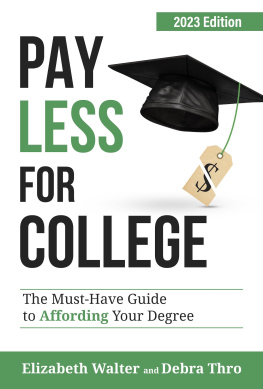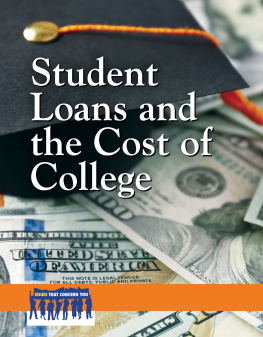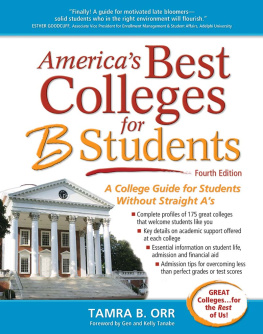100 Ways
to Cut the
High Cost of
Attending College
MONEY-SAVING ADVICE
FOR STUDENTS AND PARENTS
Michael P. Viollt

Copyright 2002 by Michael P. Viollt
All rights reserved.
No part of this book may be reproduced in any form or by any electronic or mechanical means, including information storage and retrieval systems, without written permission from the publisher, except by a reviewer who may quote passages in a review.
Published by Cooper Square Press
A Member of the Rowman & Littlefield Publishing Group
200 Park Avenue South, Suite 1109
New York, New York 10003-1503
Distributed by National Book Network
Library of Congress Cataloging-in-Publication Data
Viollt, Michael P., 1951
100 ways to cut the high cost of attending college : money-saving advice for students and parents / Michael P. Viollt.
p.cm.
Includes bibliographical references.
ISBN 0-8154-1203-7 (paper : alk. paper)
1. Student aidUnited States. 2. College studentsUnited StatesFinance, Personal. I. Title: One hundred ways to cut the high cost of attending college. II. Title.
LB2337.4.V56 2002
379.3dc21
2002001046
The paper used in this publication meets the minimum  requirements of American National Standard for Information SciencesPermanence of Paper for Printed Library Materials, ANSI/NISO Z39.481992.
requirements of American National Standard for Information SciencesPermanence of Paper for Printed Library Materials, ANSI/NISO Z39.481992.
Manufactured in the United States of America.
Contents
Acknowledgment
One of the great strengths of America is its rich and diverse system of higher education. Collectively the colleges and universities of this system make a college education attainable for just about everyone. This equal opportunity for quality education is the envy of every other nation on the planet. All of the other countries of the world understand that education is the foundation of prosperity and the great equalizer of all mankind.
This formula for national success is based upon the assumption that we can continue to provide affordable college options to all prospective students. I hope this book will help my daughters Anne and Sarah, their friends, and an entire generation find the college that best meets their needs. All who use this book to that end owe a great deal of gratitude to Petra and Meagan for their valuable insight and assistance with the production of this work.
Introduction
Most students report that their number one concern regarding college is affordability. They have good reason for concern, considering that the cost of college continues to increase at twice the rate of inflation. This annual cost spiral has many families and individuals wondering if they will be able to pay for a college education.
College costs are a much larger percent of family income than they were just ten years ago. During the 1990s, median family income rose 38 percent while college tuition went up nearly 60 percent and 80 percent at private and public colleges respectively. For high school graduates and adults going to college, these tuition increases have made attaining a degree a very expensive proposition. Cost is the number one reason that less than half of all college students graduate. But cost need not keep you from earning a degree. As you select a college, remember that you can find quality in every price range. You can spend $200,000 for a college education or $11,000, and often get the same return on your investment as measured by lifetime earnings or more qualitatively by things such as lifestyle, friendships made, and personal development. The trick is to find the right fit for you.
Tuition prices offer just one measure of the cost of higher education. Actual cost is impacted by the amount of financial help you receive, the number of terms you are enrolled, the educational value you receive, and the overall return on your investment. After considering tuition and fees, the largest variable in college cost is the amount of financial aid that you receive from outside sources and the financial aid (discount) offered to you by the college or university. In a college class of twenty students, every one of them may pay a different tuition rate after including scholarships and grants (discounts). Tuition rates often have little to do with the underlying cost of delivering the education. In this way, they work similar to the price tag on perfume, where the basic ingredients are the same in all perfumes but prices vary greatly based upon the status position of the product. The price of a college is often set to align the college with other schools in a certain class. Colleges have a perceived value that may or may not reflect the true quality of the education. Other variances in tuition can hinge on the amount of tax support a college receives, the size of the colleges endowment fund (savings), its location, the amount of research conducted at the college, faculty teaching load and a number of other factors.
Financial assistance comes from a large number of sources, and for many students, this aid determines where they can go to college. About three-fourths of all students receive financial aid. Most, about 80 percent of the aid, comes from government sources, while most of the remainder comes from the schools themselves. For the average student, aid covers about 40 percent of college costs. This aid is broken into 40 percent grants and 60 percent loans. The loans will have to be paid back with interest. The grants are not paid back.
Even with financial aid, most families will be stretched to meet college costs. As with anything else of value in life, you will have to make sacrifices to earn your degree. You need to decide in advance what trade-offs you are willing to make in your quest to keep college affordable. Which of your important college selection criteria are you willing to give up?
As the cost of an education increases, you are forced to look at college as an investment. When you consider that even after discounts and other sources of help, the average student graduates with $18,000 in debt, it is no wonder that students want to get the most out of every dollar.
You can achieve the softer college resultsmaturing, friendship development, group activities, special-interest development, value creation, etc.at just about any college. For most students, the right fit is the college that provides for most of their education and experience wants, yields solid career results, and is affordable.
You can succeed in life without a college educationit is just a lot harder to do. College is available and affordable for just about everyone. Take the time to find the college that best fits your needs and you will have made an affordable choice. I hope this book will help you do that.
CHAPTER
The Three Elements of College Affordability
It is true that there is more to selecting a college than dollars and cents, but affordability is the most critical concern for most college students. The 100 cost-saving strategies in this book will help you make the most of your college dollar. The strategies fall into three basic categories: lowering the price of tuition and fees, maximizing the value received for your investment, and increasing the amount of money you receive from other sources. Before you begin to investigate the 100 tips, spend a little time learning how the three categories work together to impact affordability. It will help you in your planning to understand why there is such great variability in the cost of an education.










 requirements of American National Standard for Information SciencesPermanence of Paper for Printed Library Materials, ANSI/NISO Z39.481992.
requirements of American National Standard for Information SciencesPermanence of Paper for Printed Library Materials, ANSI/NISO Z39.481992.